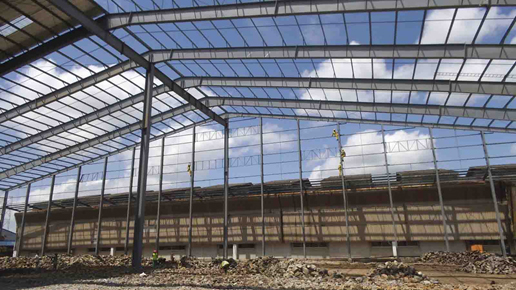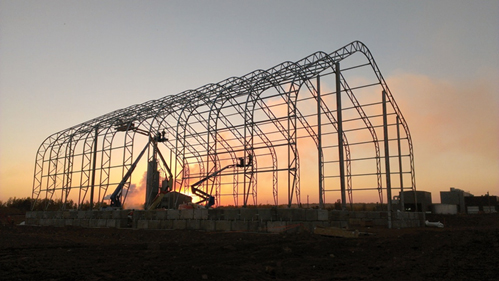PRE ENGINEERED BUILDINGS

PRE ENGINEERED BUILDINGS
A pre-engineered steel building is a modern technology where the complete designing is done at the factory and the building components are brought to the site in CKD (completely knock down condition) and then fixed/jointed at the site and raised with the help of cranes.
Ebase Infratech is one of the most trusted and leading Pre Engineered Building Manufacturers in India. We take note of all the ISI specifications while manufacturing and designing all the structures and make sure that all our structures are economical as well as safe. Pre Engineered Building is customized as per the needs and requirements of the customer and are made to suite a wide range of application in different industry sectors. These buildings are unlike conventional buildings in ways like speed in erection and delivery, flexibility and they can even withstand severe weather conditions. We can proudly say that we are NO. 1 Pre Engineered Manufacturers in India and we are also a one stop provider for all the structural needs and have various products ranging from stairs, Canopies, Portal cabins, floors etc.
WHAT ARE PRE-ENGINEERED METAL BUILDINGS?
Pre-engineered metal buildings (PEMB) use a combination of:
- Structural steel framing system
- Metal roofing system
- Wall panels of varying materials
High-quality wall panels can be fully customized and come in a variety of choices, from single skin sheeting with added insulation to insulated sandwich panels. The concept is designed to provide a complete building envelope system which is:
- Air-tight
- Energy efficient
- Optimum temperature control
- above all, designed to suite specific user specifications
Pre-engineered steel buildings can be fitted with different structural accessories including mezzanine floors, canopies, fascia’s, interior partitions etc. and the building is made water proof by use of special mastic beads, filler strips and trims.
ADVANTAGES OF PEBs
- Reduction in Construction Time: Buildings are typically delivered in just a few weeks after approval of drawings. Foundation and anchor bolts are cast parallel with finished, ready for the site bolting. In India the use of pre-engineered buildings will reduce total construction time of the project by at least50%. This also allows faster occupancy and earlier realization of revenue.
- Lower Cost: Due to the systems approach, there is a significant saving in design, manufacturing and on site erection cost. The secondary members and cladding nest together reducing transportation cost.
- Flexibility of Expansion: Buildings can be easily expanded in length by adding additional bays. Also, expansion in width and height is possible by pre-designing PBEs for future expansion.
- Quality Control: As metal structures are manufactured completely in the factory under controlled conditions the quality is easier to manage vs. on project sites.
- Low Maintenance: Buildings are manufactured with the highest quality paint for cladding and steel, applied in a controlled environment, which results in long durability and low maintenance costs.
- Energy-Efficient Roofing and Wall Systems: Buildings can be supplied with polyurethane insulated panels or fiberglass blanket insulation to achieve required U values.
- Single Source Availability: As the complete building package is supplied by a single vendor, compatibility of all the building components and accessories is assured. This is one of the major benefits of the pre-engineered building systems.
Aren’t Pre-Engineered Buildings Just Ugly Metal Boxes Made From Cheap Materials?
NO! This is perhaps the hardest hurdle to jump because we’ve found that most people believe this is true. The idea that you cannot design or customize metal buildings to be architecturally pleasing is false. The stigma that pre-engineered is cookie cutter and “off the manufacturing line” persists, but it could not be further from the truth that you can’t custom design PEB's. And, the idea of PEB’s manufactured with lower-quality materials couldn’t be further from the truth. PEB’s are designed and manufactured to meet or exceed any and all local building codes and often come with warranties for the lifetime of the structure.
How Do You decide if a Pre-Engineered Building is Right for Your Project?
PEB’s are not the right or best system for all building types so let Ebase help guide you on the type of building system that best suits your project needs. Whether the right building system is conventional steel frame, structural pre-cast concrete, or PEB, you don’t have to sacrifice design or creativity by choosing one over the other. Teamed with the right design professional you can have it all. Partnering with Ebase early in your new building planning phase, you can rest assure that your project will be customized to meet your needs.
APPLICATION OF PEB
Almost every conceivable building use has been achieved with PEB; the most common applications are industrial, institutional and commercial buildings.
In India, Pre-engineered building systems find application primarily in the construction of Warehouses, & Industrial sheds & Buildings. The recent focus has also shifted to cover rural as well as urban, individual and mass housing projects, farmhouses, slum re-organization projects and rehabilitation projects, amenity structures like health centers, kiosks, primary schools, panchayat etc. The pharmaceutical industries and exhibition centers, and functional requirements like offices, seminar halls, call centers, supermarkets, showrooms etc. have also attracted PEB. Earthquake-resistant buildings are the recent applications of PEB with wide and immediate acceptance.
Applications of Pre Engineered steel buildings include:-
- Houses & Living Shelters.
- Factories.
- Warehouses.
- Sports Halls (Indoor and Outdoor).
- Aircraft Hangers.
- Supermarkets.
- Workshops.
- Office Buildings.
- Labor Camps.
- Petrol Pumps/Service Buildings.
- Schools.
- Community centers.
- Railway Stations
- Equipment housing/shelters.
There is a great possibility of improving the aesthetic quality with a choice of roofing elements, exterior finishes, weather-sheds, color system and variations in planning as well as massing.
PEB PROSPECT’S IN THE WORLD
Technological improvement over the years has contributed immensely to the enhancement of quality of life through various new products and services. One such revolution was the pre-engineered buildings. Through its origin can be traced back to 1960s its potential has been felt only during the recent years. This was mainly due to the development in technology, which helped in computerizing the design. PEB concept has been very successful and well established in North America, Australia and is presently expanding in UK and European countries. PEB construction is 30 to 40% faster than masonry construction. PEB buildings provide good insulation effect and would be highly suitable for a tropical country like India. PEB is ideal for construction in remote & hilly areas. A recent survey by the Metal Building Associations (MBA) shows that about 60% of the nonresidential low rises building in USA are pre-engineered buildings.
PEB PROSPECTS IN INDIA
Although PEB systems are extensively used in industrial and many other nonresidential constructions worldwide, it is relatively a new concept in India. These concepts were introduced to the Indian markets lately in the late 1990s with the opening up of the economy and a number of multinationals setting up their projects. India has an installed steel capacity of 35 to 40 million tones & apparent steel consumption is around 27 to 30 million tones. The current Pre-Engineered steel building manufacturing capacity is 0.35 million tons per annum. The industry is growing at a compound rate of 25 to 30 %.
FUTURE OF PEB
The steel structures (SS) market in India is in excess of 4.5 Mn.MT, growing at a rapid pace of more than 10% p.a. over the past few years. This market has experienced a higher growth compared to both Indian steel industry as well as Indian construction GDP. Overall construction sector accounts for majority (greater than 80%) of the steel structures market (volume terms) in India.


